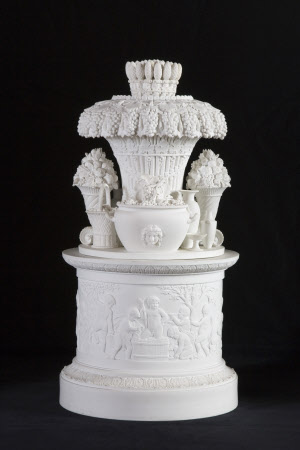'Autumn', or 'the Bunch of Grapes'
Alexandre-Théodore Brongniart (1739 - 1813)
Category
Ceramics
Date
8 Nov 1816
Materials
hard-paste biscuit (unglazed) porcelain
Measurements
510 mm (Height); 250 mm (Diameter)
Place of origin
France
Order this imageCollection
Uppark House and Garden, West Sussex
NT 137578
Summary
'Autumn', or 'the Bunch of Grapes', a biscuit centerpiece, made at Sèvres, France, 1816. A Sèvres centrepiece or gerbe in the form of a trophy composed of attributes characteristic of autumn, supported upon a circular base on socle, with bas-relief of children personifying the four seasons, designed by Alexandre-Theodore Brongiart (1739-1813), modelled by Jean-Charles-Nicolas Brachard (1766-1846) and finished by Jean-Nicolas-Alexandre Brachard (1775-1843). The base or socle bears the date mark for 8 November 1816 and the modeller's mark AB for Alexandre Brachard. White biscuit porcelain.
Full description
Emblematic of autumn, this Sèvres biscuit porcelain group was made for a grand surtout de table (an ensemble ornamenting the centre of a table) known as the surtout ‘des Saisons’ (‘the Seasons’). It exemplifies the imperial style created by the manufactory’s director, Alexandre Brongniart (1770–1847), for Napoleon. The triumphs of the Napoleonic regime were evoked in Sèvres porcelain to be used as political currency, both in the form of diplomatic gifts and for imperial use. During a time of social upheaval, numerous imperial commissions revived the struggling manufactory, which was competing against commercial Parisian factories. Brongniart, a talented young chemist and mineralogist appointed as director in 1800, worked in tandem with the leading French artists and designers to create a style that met the needs and pretensions of the Emperor, while also showcasing the technical prowess of the manufactory. Between 1804 and 1814, four monumental sculptural surtouts de table in biscuit porcelain were ordered with specific themes that matched the accompanying service ware. Two, the service Olympique (1804–7) and service Égyptien (1804–8), were presented to Alexander i of Russia in 1807 and 1808 respectively. A third, the service de l’Empereur (1807–10), also known as the service des quartiers généraux, was made for the wedding of Napoleon and Marie-Louise in 1810. The fourth, the service ‘des Saisons’, was designed in 1811–12, to accompany the service pittoresque à bordure d’or, apparently richly painted with ‘scenes representing all kinds of subjects’. However, neither service was supplied to the court, as production was terminated by Napoleon’s abdication in 1814. Made in the new hard-paste porcelain body perfected by Brongniart, the surtout ‘des Saisons’ was designed by his father, the architect Alexandre-Théodore Brongniart (1739–1813), a leading arbiter of taste at Sèvres during the First Empire. This part of the surtout, a group known as Gerbe de raisins (‘The Bunch of Grapes’), takes the form of a trophy composed of attributes of autumnal produce, including, as well as grapes, antique vessels associated with wine and drinking. This symbol of abundance and industry, a tribute to France’s viticulture, was intended to illustrate the country’s overflowing riches under Napoleon. The theme is continued on the circular socle with a bas-relief of children emblematic of the four seasons. The group was intended to have a pendant, Gerbe de blé (‘The Sheaf of Wheat’), of attributes associated with summer and symbols of agriculture, but this survives only as a plaster model and an engraving. No designs or plaster models survive for groups emblematic of winter or summer. Elements from the services were sold as individual models. On 21 July 1819, the manufactory’s register records the sale of ‘1 Gerbe in biscuit, grapes, &c, 600 francs (discount of 10% applies in his capacity as a purchaser for resale)’ to the Parisan ébénistes Jacob-Desmalter & Cie, acting as agent for Sir Harry Fetherstonhaugh of Uppark (1754–1846). An undated list of his purchases subject to customs duty records ‘un biscuit de Sevres’, together with ‘deux vases ditto’, which in total cost 1,100 francs. The Napoleonic provenance doubtless appealed to Sir Harry, who commissioned a plaster bust of the Emperor for the dining room at Uppark. Having survived major sales from Uppark in 1910 and 1911, the gerbe de raisins was privately sold in the 1970s. Unknown until its reappearance on the art market with an Uppark provenance in 1997, it was purchased by the National Trust from the dealer Errol Manners, with the aid of the Art Fund. Text adapted from Patricia F. Ferguson, Ceramics: 400 Years of British Collecting in 100 Masterpieces, Philip Wilson Publishers, 2016.
Provenance
Probably commissioned from the Sèvres manufacture by the household of Emperor Napoleon Bonaparte; purchased by Sir Harry Fetherstonhaugh, 2nd Bt. (1754-1846), in 1819, and thence by descent; photographed at Uppark, 1900; sold 1970s; purchased by the National Trust, 1998, with the help of a grant from the Art Fund.
Credit line
National Trust Collections (Uppark, The Fetherstonhaugh Collection)
Marks and inscriptions
‘SZ’ incised on the socle, the date code for 8 November 1816, and ‘AB’ for Alexandre Brongniart (1770–1847).
Makers and roles
Alexandre-Théodore Brongniart (1739 - 1813), designer Jean-Charles-Alexandre Brachard (1775 - 1843), modeller Jean-Nicolas-Alexandre Brachard (1766 - 1846), publisher
References
Rowell, 1999: Christopher Rowell. “A Sèvres biscuit centrepiece by Alexandre-Théodore Brongniart restored to Uppark.” Apollo 149.446 (1999): pp.54-57. Ferguson 2016: Patricia F. Ferguson, Ceramics: 400 Years of British Collecting in 100 Masterpieces, Philip Wilson Publishers, 2016, 176-7

